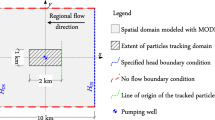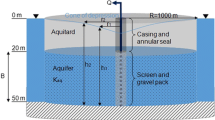Abstract
Existing models are built upon to develop new ones. As a foundational model in porous media flow, the Darcy flow model has been built upon by many researchers. The groundwater flow equation evolved from the Darcy equation. Dupuit–Forchheimer built upon it to develop the simplified forms for both the confined and unconfined aquifers flow, usable for studying groundwater flow into wells. Aside from height, permeability, and availability of water in the aquifers, other factors influence groundwater flow into wells, as enshrined in the flow equation. This paper investigates the roles of storability, hydraulic conductivity, and source/sink strength in both confined and unconfined groundwater flow into wells using the Dupuit–Forchheimer assumption. In this model, the Dupuit–Forchheimer pressure assumption is substituted into the groundwater flow equations and solved using the Bessel form for separation of variable technique, and Mathematica 11.2 computational software to obtain the expressions for the pressure, which are computed and presented quantitatively. The results show that an increase in the hydraulic conductivity and storability have no effect on the flow pressures in the confined and unconfined aquifers but cause fluctuation in the pressure structure in the unconfined aquifer; the source/sink strength factor causes fluctuation in the pressure structures in both confined and unconfined aquifers flow. However, in both confined/unconfined aquifers the pressures increase as the radii of the wells increase. Importantly, the fluctuation in the pressure structures causes a loss of energy for groundwater flow into the wells.
Similar content being viewed by others
Availability of data and material
Not applicable.
Code availability
Available on request.
Reference:s
Brinkman HC (1949) A calculation of the viscous force exerted by a flowing fluid on a dense swarm of particles. Appl Sci Res 1:27–34. https://doi.org/10.1007/BF02120313
Chen YF, Zhou JQ, Hu SH, Hu R, Zhou CB (2015) Evaluation of Forchheimer equation coefficients for non-Darcy flow in deformable rough-walled fractures. J Hydrol 529(3):993–1006
David I, Stefănescu C, Grădinaru C, Vlad I, Gabor C (2015) Mathematical modelling of groundwater flow in aquifers which contain extraction/infiltration cavity of arbitrary shape, using the theory of functions of a complex variable. In: Proceedings of the International Conference on mathematical methods, mathematical models and simulation in science and engineering (MMSSE 2015). Vienna (March 1–17)
Dukhan N, Patel K (2011) Effect of sample’s length on flow properties of open-cell metal foam and pressure-drop correlations. J Porous Mater 18(6):655–665
Haitjema H, Kuzin S, Kelvin V, Abraham D (2011) Modelling flow into horizontal wells in a Dupuit–Forchheimer model. Groundwater 49(6):949
Mathias SA, Todman LC (2010) Step-drawdown tests and the Forchheimer equation. Water Resour Res 46(7):W027514
Mehdinejadiani B, Naseri AA, Jafari H, Ghanbarzadeh A, Baleanu D (2013) A mathematical model for simulation of a water table profile between two parallel subsurface drains using fractional derivatives. Comput Math Appl 66:785–794
Mehta MN (1975) A singular perturbation solution of one-dimensional flow in unsaturated porous media with small diffusivity coefficient. In: Proceedings of the National Conference on Fluid Mechanics and Fluid Power (FMFP ’75), pp E1–E4
Mussa KR, Mjemah IC, Muzuka A (2020) A review on the state of knowledge, conceptual and theoretical contentions of major theories and principles governing groundwater flow modelling. Appl Water Sci 10:149–158
Mwetulundila AL, Atangana A (2020) Applying the Forchheimer equation to model an artificially recharged fractured aquifer. Alex Eng J 59:2115–2130
Patel K, Mehta M, Patel T (2012) A series solution of moisture content in vertical groundwater flow through unsaturated heterogeneous porous media”. Int J Math Eng 159(1):1467–1477
Philips R (1970) Advances in hydro science. In: Chow V (ed) Academic Press, New York
Prickett TA (1975) Modelling techniques for groundwater evaluation. Adv Hydrosci 10:1–143
Shi W, Yang T, Liu H, Yang B (2018) Numerical Modelling of non-Darcy flow behaviour of groundwater outburst through faults using the Forchheimer equation. J Hydrol Eng 23(2):04017062
Shreekant PP, Twinkle S (2014) An analysis on groundwater recharge by mathematical model in inclined porous media. Int Sch Res Not. https://doi.org/10.1155/2014/189369
Skejetne E, Auriault JL (1996) New insight on steady non-linear flow in porous media. Eur J Mech B/fluids 18(1):131–145
Srinivasan S (2016) A generalized Darcy–Dupuit–Forchheimer model with pressure-dependent drag coefficient for flow through porous media under large pressure gradient. Transp Porous Media
Strack DL (1995) A Dupuit–Forchheimer model for 3-D flow with variable density. Water Resour Res 31(17):3002–3017. https://doi.org/10.1029/95WR02254
Swaroop A, Mehta MN (2001) A solution to the problem of one-dimensional flow in unsaturated porous media taking finite element approach. In: Proceedings of the International Conference on Mathematical Modelling, pp 141–143
Szczepinski J (2019) The significance of groundwater flow modelling study for simulation of open cast mine dewatering flooding and environmental impact. Water 11:848–863
Thangarajan M (2007) Groundwater Models and their roles in assessment and management of groundwater resources and pollution. In: Thangarajan M (ed) Groundwater. Springer, New York
Vazguez-Baez VM, Rubio-Arellano A, Toral DG, Mora JIR (2019) Modelling an aquifer: numerical solution to the groundwater equation. Math Probl Eng 8:1–9. https://doi.org/10.1155/2019/1613726
Venkataraman P, Rao PRM (1996) Darcian, transitional and turbulent flow through porous media. J Hydraul Eng 124(8):840–846
Verma A, Mishra S (1973) A similarity solution of a one-dimensional vertical groundwater recharge through porous media. Rev Roum Sci Tech S´erie de M’ecanique Appliqu’ee 18(2):345–351
Yao YD, Li GZ, Qin PF (2015) Seepage features of high velocity non-Darcy flow in highly productive reservoirs. J Nat Gas Sci Eng 27(3):1732–1738
Zerihun YT (2018) Extension of the Dupuit–Forchheimer model for non-hydrostatic flows in unconfined aquifers. Fluids 3(42):1–20
Zhou Y, Li W (2011) Gave review of regional groundwater flow modelling. Geosci Front 2(2):205–214
Zhou JQ, Hu SH, Chen YF, Wang M, Zhou CB (2016) The friction factor in the Forchheimer equation for rock fractures. Rock Mech Rock Eng 49(8):3055–3068
Funding
The author(s) received no specific funding for this work.
Author information
Authors and Affiliations
Contributions
All authors whose names appear on this article made substantial contributions in the following ways: conception or design of the work, analysis, and interpretation of data.
Corresponding author
Ethics declarations
Conflict of interest
On behalf of all the co-authors, the corresponding author states that there is no conflict of interest.
Ethics approval
Not applicable.
Consent to participate
Not applicable.
Consent for publication
All authors gave their consent for this article to be published in your journal.
Additional information
Publisher's Note
Springer Nature remains neutral with regard to jurisdictional claims in published maps and institutional affiliations.
Rights and permissions
About this article
Cite this article
Okuyade, W.I.A., Abbey, T.M. & Abbey, M.E. Application of the Dupuit–Forchheimer model to groundwater flow into a well. Model. Earth Syst. Environ. 8, 2359–2367 (2022). https://doi.org/10.1007/s40808-021-01224-2
Received:
Accepted:
Published:
Issue Date:
DOI: https://doi.org/10.1007/s40808-021-01224-2




